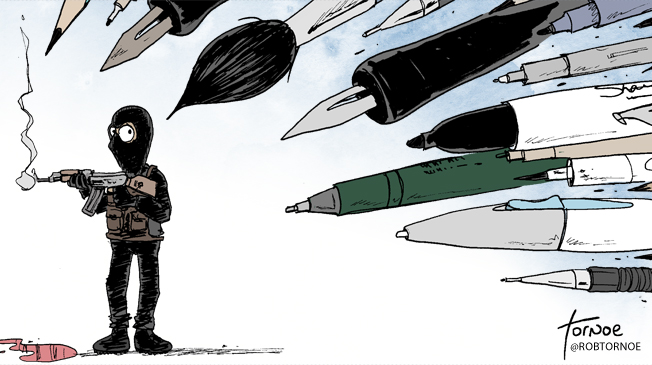The recent attack on Charlie Hebdo, a weekly satirical French newspaper featuring acerbic cartoons and comics, is shocking. Twelve people are dead, 11 injured. These attacks threaten the freedom of the press. But the media’s response has been troubling. Coverage lionizes Charlie Hebdo as an institution, while also taking advantage of the cartooning community.
Charlie Hebdo’s editorial mission is to hold power to account with sometimes crude, often offensive visual commentary and reporting. Imagine a more pungent version of The Onion, in which no institution is sacred or immune to hyperbolic mockery. In 2011, the magazine’s offices were firebombed following the publication of an issue with the Prophet Muhammad on the cover.
In the 48 hours after the attack, media industry response has been mixed. Most approaches venerate Charlie Hebdo and seek to ally themselves with the outlet under the hashtag #JeSuisCharlie. It’s an understandable response: This act of terrorism threatens freedom of expression on an international scale.
But Charlie Hebdo isn’t sacred, either. It often crossed the line. In a comprehensive overview of Charlie Hebdo’s track record, Jacob Canfield writes that “[w]hile they generously claim to ‘attack everyone equally,’ the cartoons they publish are intentionally anti-Islam, and frequently sexist and homophobic.” Canfield cites one example in particular, a cover in which Boko Haram sex slaves were drawn as welfare moms.
Some media organizations are censoring and selectively cropping Charlie Hebdo’s work, perhaps to avoid retaliation or offense. But for the public to understand the scope of these attacks and what might have incited them, it is vital for us to make the visual connection regarding how simple drawings caused such controversy.
Furthermore, while glorifying Charlie Hebdo, outlets are simultaneously thumbing their noses at the cartooning industry. Outlets quickly aggregated and storified the responses of cartoonists, usually by embedding tweets, without contacting artists to obtain rights. (Two notable exceptions: Medium’s The Nib and Fusion’s Graphic Culture are only publishing work with permission, and they’re both paying for what they publish.) It’s a natural evolution of the digital media landscape, where explainers and roundups are king. This process is also unethical. Cartoonists, especially those who work in the journalism space, are often on the front lines of cultural conflict. They receive threats of physical harm and are often freelancers. They often make very little money for hours of hard work.
Charlie Hebdo is important as an outlet because it is one of the few news organizations to actively employ and engage cartoonists in the journalistic process. As the cofounder, editor and publisher of Symbolia, a magazine that merges comic books and journalism, I’ll admit that Charlie Hebdo is, while flawed, one of our primogenitors. Political cartooning is on the wane. As cartoonist Ted Rall wrote in response to the attacks:
More full-time staff political cartoonists were killed in Paris yesterday than are employed at newspapers in the states of California, Texas and New York combined.
More full-time staff cartoonists were killed in Paris yesterday than work at all American magazines and websites combined.
If you want to stand in solidarity with the community reeling from these attacks, support the people working to help you understand the world. Visual storytelling is more important than ever. Examine Charlie Hebdo’s coverage for yourself, without the gloss of veneration. Pay a cartoonist for their work. It’s a good place to start.
Art: Rob Tornoe, with whom Polgreen split the fee for this piece.
Erin Polgreen is the cofounder of Symbolia, a magazine that mixes comic books and journalism. She regularly consults with media outlets and foundations on innovation. Follow her on Twitter @polgreen.
Editors’ note: In line with our standard editorial practice and Twitter’s terms of use, yesterday TPM embedded tweets of editorial cartoons which had been tweeted and thus shared by the artists themselves.







Bravo! All this big media ‘wrestling’, as the Washington Post headlines the alleged professional angst is embarrassing and a stark portrait of American journalism today to say nothing of the lack of confidence and the disrespect this attitude displays toward the men and women currently engaged in protecting America. Along with the New York Times, the AP’s desire not to publish anything intending to “provoke or intimidate” stands in sharp contrast to their own relatively bland modern self description as that of a “newsgatherer” and explains a great deal about the Bush years.
So, as I count it…terror cartoons join marches for racial justice, labor protests and anti-war protests on big media’s Too Icky List.
Big Media, Je suis Sony…
Even offensive speech has to be protected, that’s why the ACLU defends the Klan. Je suis Westboro Baptist Church.
One of the most exciting things I’ve seen come out recently is Patreon, which I think is a great way to manage the relationship between cartoonists and consumers. I wish more of my favorite web cartoonists were on it, so that I could support them directly as well.
I, for one, am not Charlie.
I don’t profit from exploiting people’s fears and hatreds in crude, unfunny cartoons.
I read years ago that the reasons Berkeley Breathed (Bloom County, Opus) and Bill Watterson (Calvin and Hobbes) ended their cartooning for newspapers was the continual shrinking of their panel allotment. That and the political environment in the USA was becoming openly hostile to cartooning.
all becuz Benghaaaaaazzziiiii and …